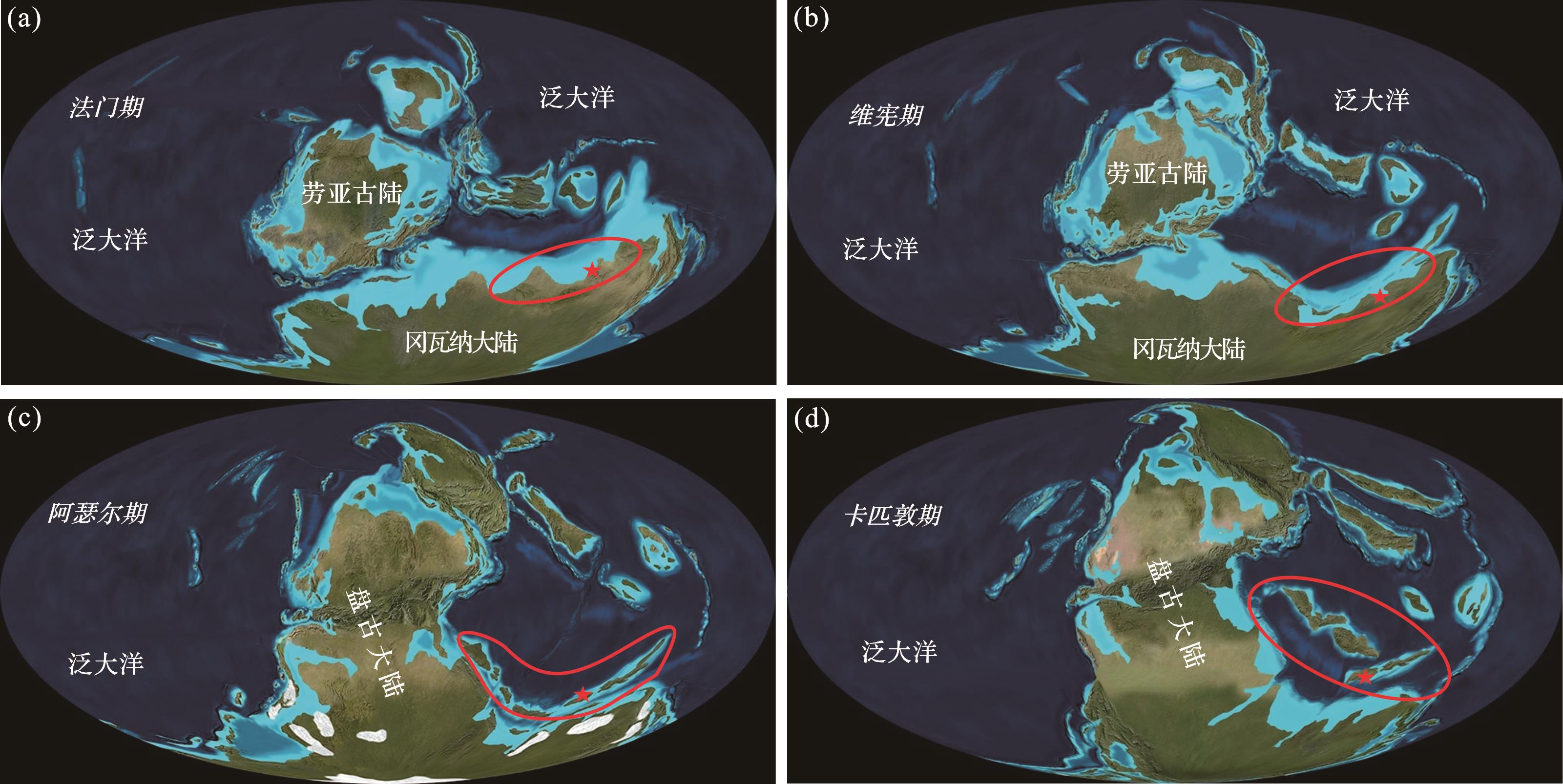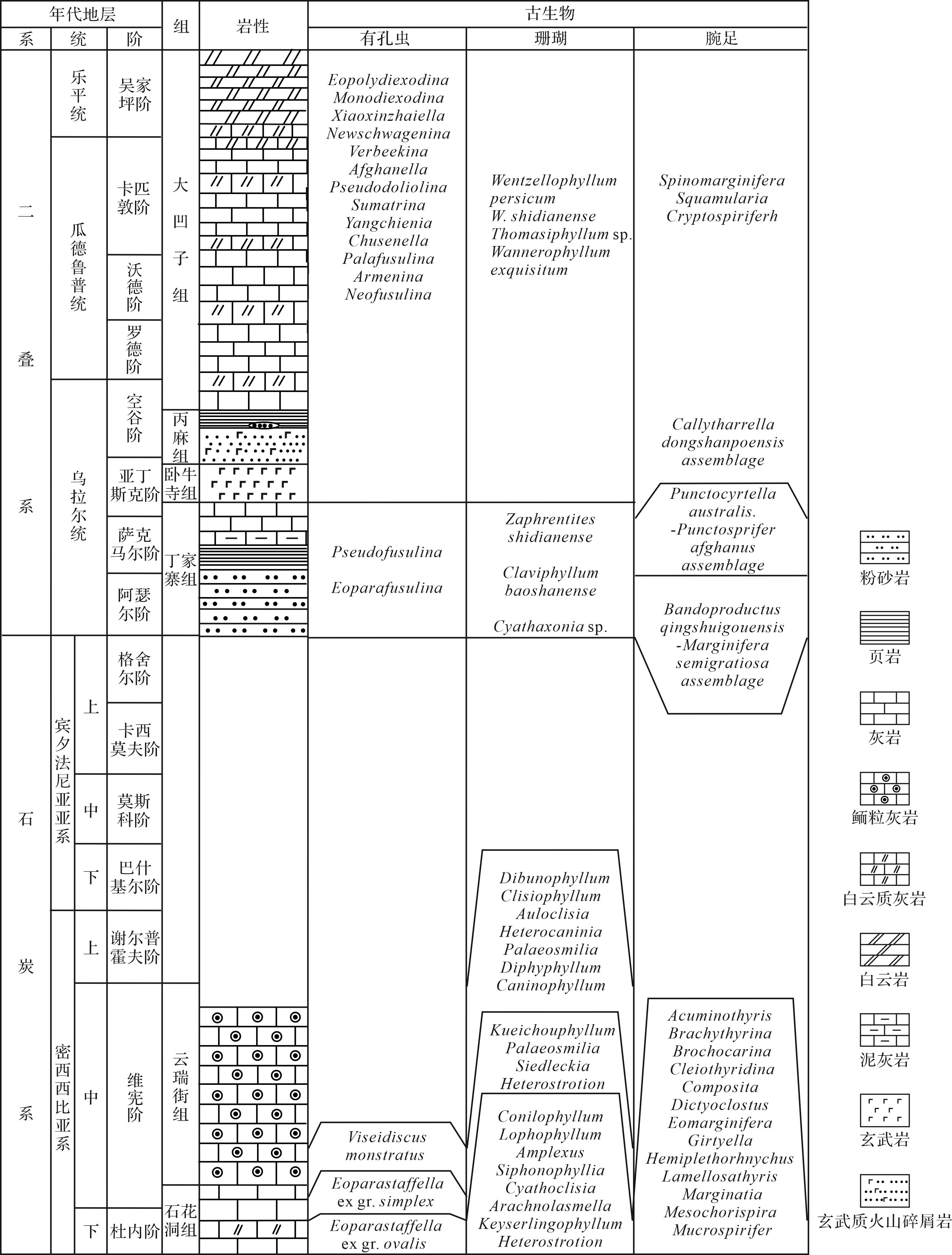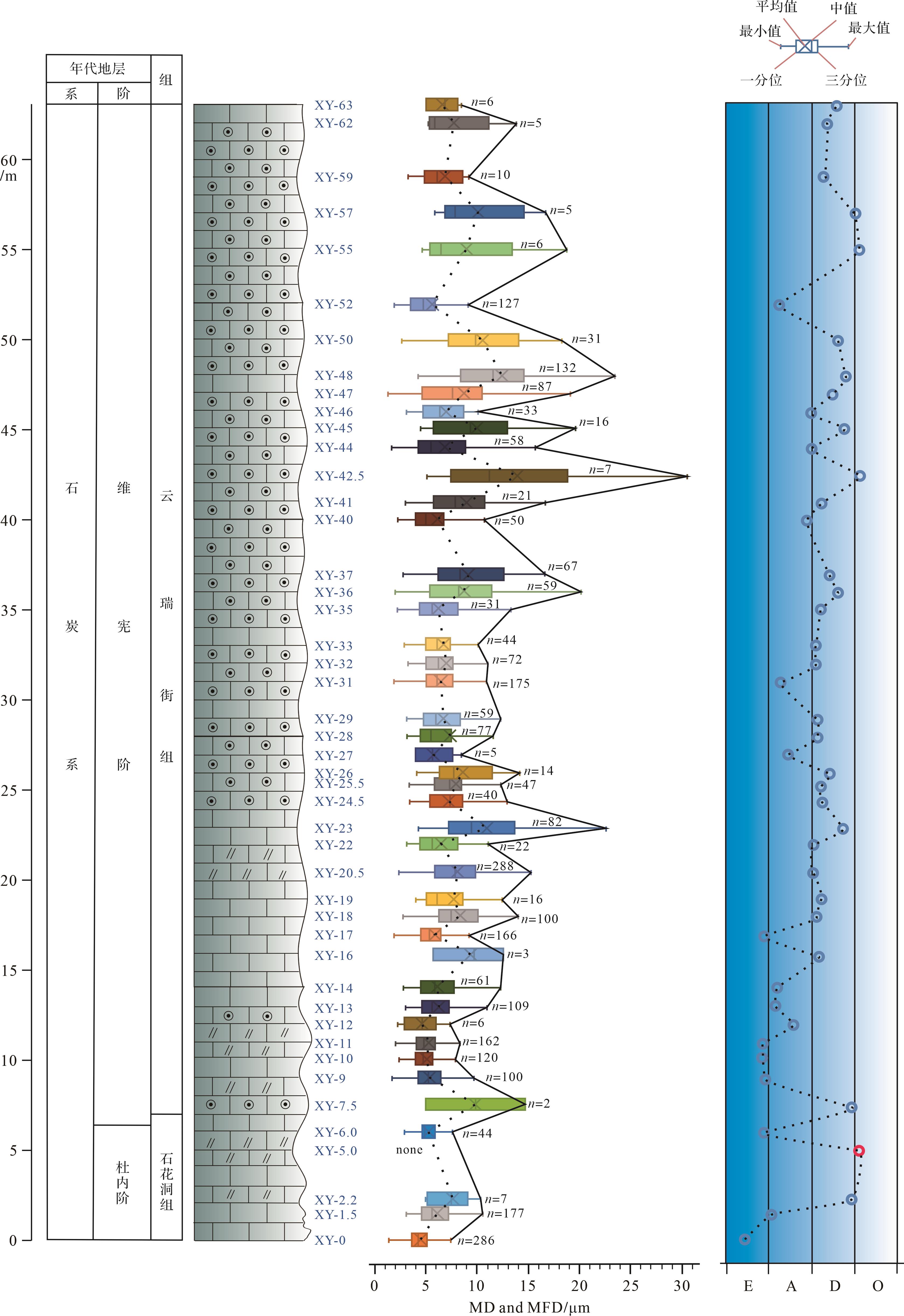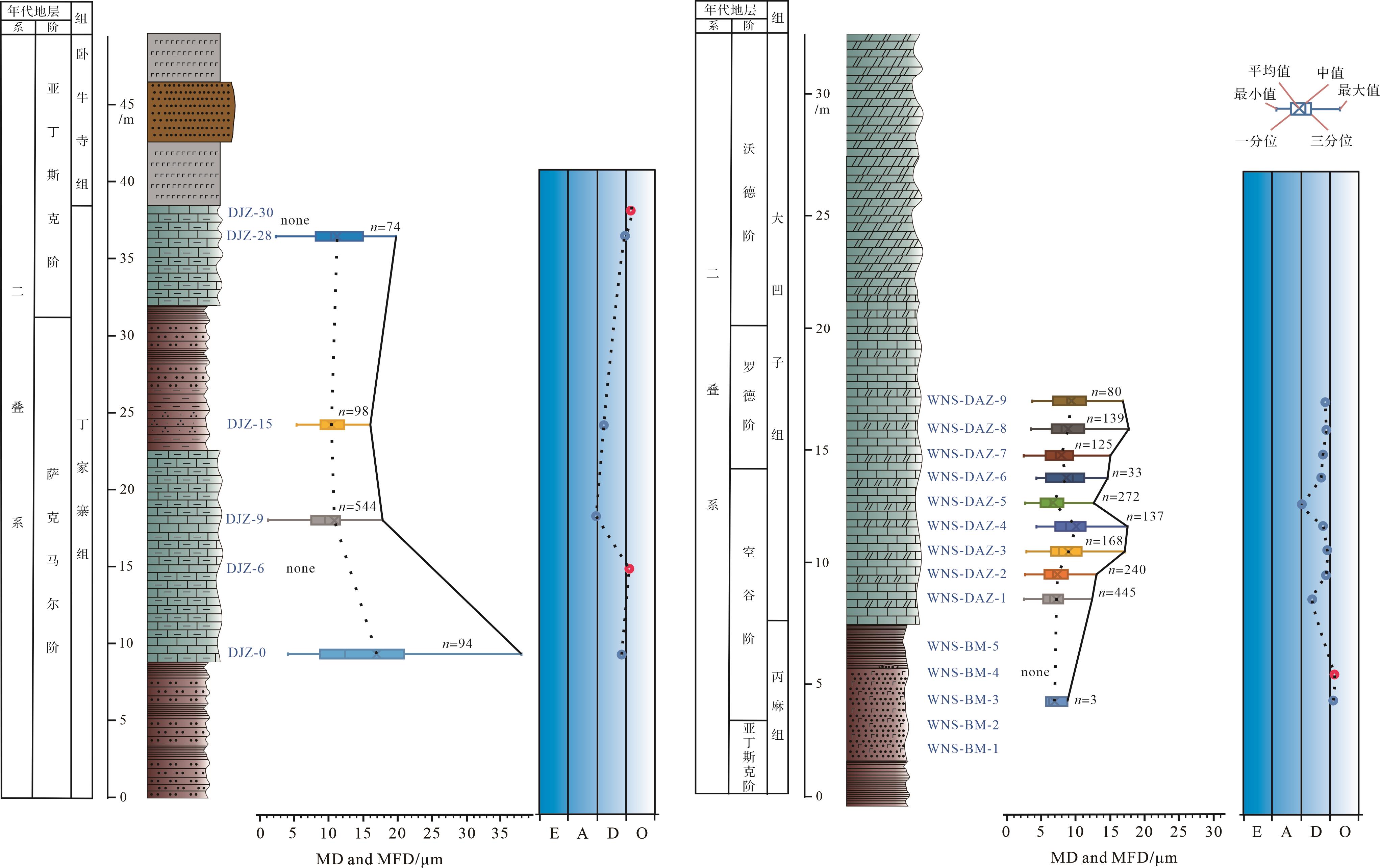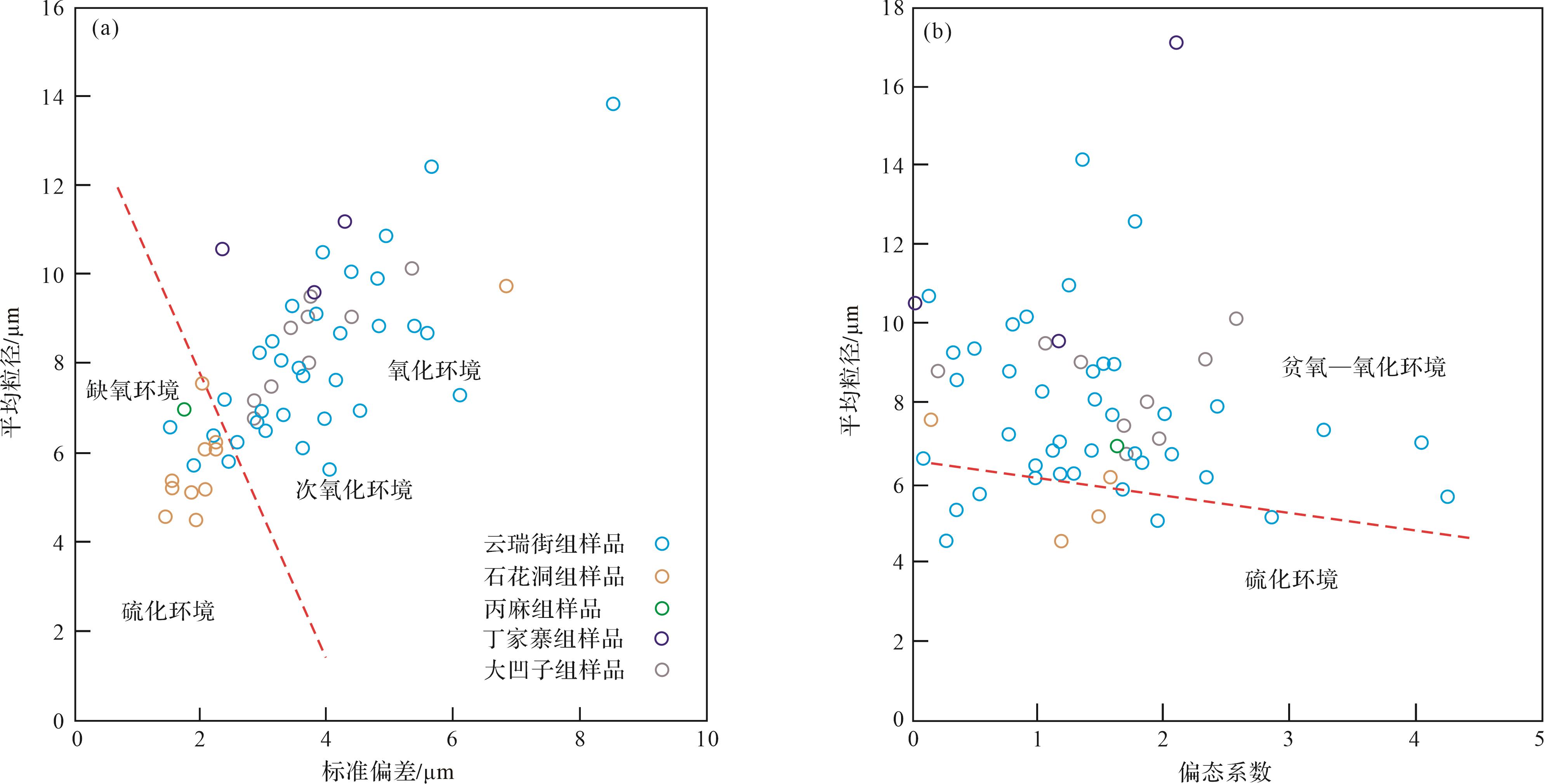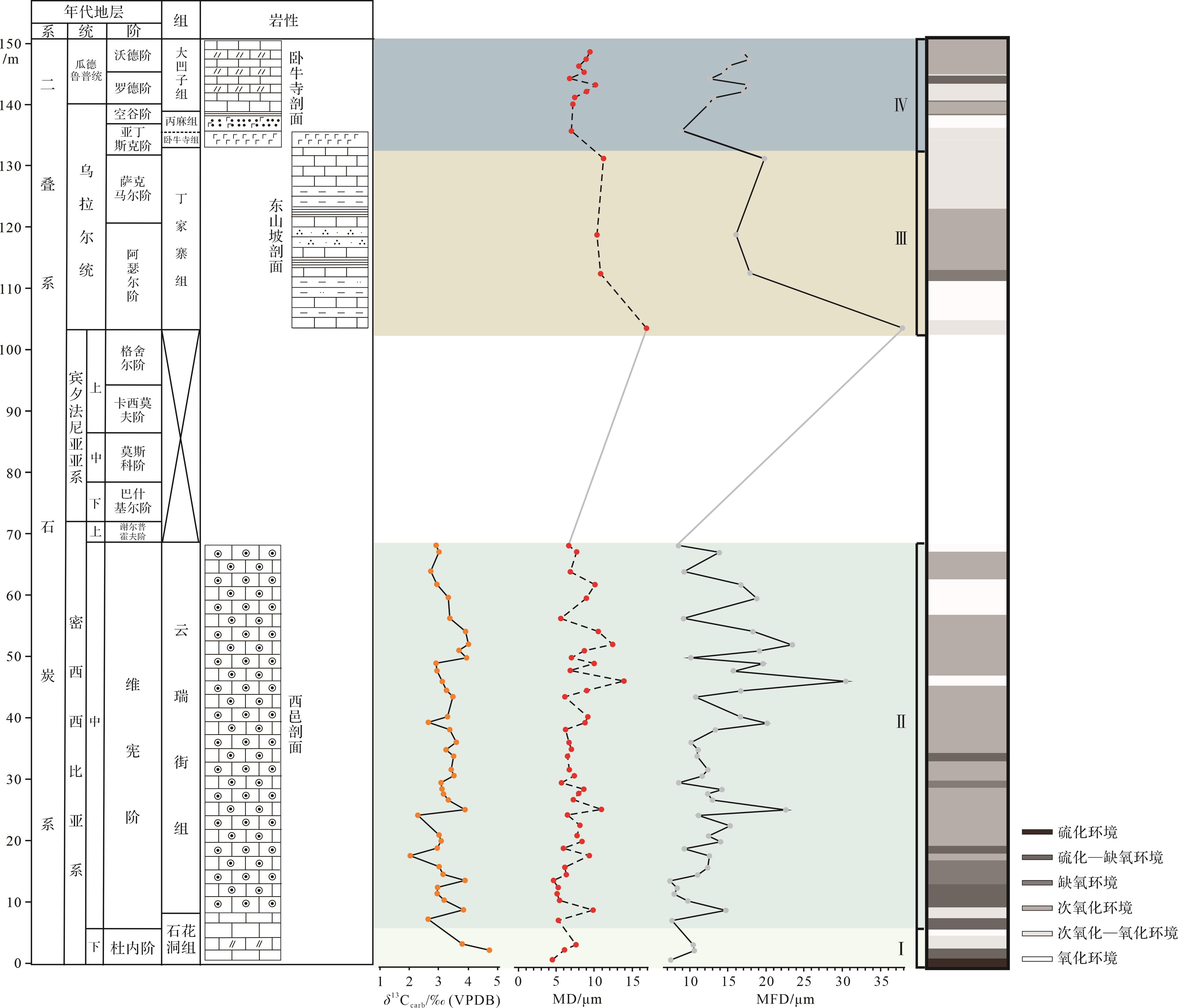HTML
-
晚石炭世—早二叠世,全球出现了较大规模的冰川事件(Late Paleozoic Ice Age,LPIA),开始进入冰室气候,冈瓦纳大陆发育冰川[1]。Fielding et al.[2]将LPIA分为三个阶段:泥盆纪—石炭纪界线附近为初始阶段、Visean-Serpukhovian期为冰川发育阶段,之后的晚石炭世—早二叠世为冰川剧烈扩张并成为大陆冰川阶段。环境变化与生物演化密切相关,在LPIA期间剧烈的环境变化过程伴随着生物的辐射、灭绝与复苏等事件,比如早石炭世晚期和中石炭生物事件[3⁃4],Kasimovian期雨林崩溃事件[5⁃6],以及石炭纪—早二叠世生物多样化辐射事件[7]。
海洋的氧化还原条件和生物事件有着十分密切的关系,通过对古海洋氧化还原条件的研究,有利于分析古海洋生物生活环境的演化,为理解地球历史上发生的重大地质历史事件提供依据[8⁃9]。LPIA时期高频率、高振幅的冰川升降活动,造成了海洋氧化还原条件快速而广泛的变化[7],并对生物演化产生重大影响。许多学者对LPIA期间古海洋氧化还原环境进行了研究[10⁃13],但对基默里地区在早石炭世—中二叠世期间连续的古海洋氧化还原环境变化还知之甚少。对于古海洋氧化还原环境的分析,主要通过地球化学指标如:主量元素(总有机碳TOC、有机碳和磷的摩尔比Corg/P)、氧化还原敏感元素(U、V、Mo)、同位素(黄铁矿硫同位素δ34Spyr、钼同位素δ98Mo、铀同位素δ238U)[14]和沉积学指标如黄铁矿类型和草莓状黄铁矿粒径分布等进行判断[15]。在氧化的海洋环境中,草莓状黄铁矿的形成与生长均需要较长的时间,从而更容易出现粒径较大的黄铁矿,且粒径均一性差;在硫化的水体环境中正相反,草莓状黄铁矿具有高的生长速率及较小的直径,并且粒径分布范围小[16⁃20]。草莓状黄铁矿粒径分析是沉积学方法,成岩改造过程中对其影响极小,因此被广泛应用于各个时代的古海洋环境恢复中[19⁃23]。本文使用此方法,对滇西保山地区石炭纪—二叠纪古海洋氧化还原环境进行恢复。
-
保山地区位于云南省西南部,南北延伸约100 km,东西宽度约10 km[24]。保山地块在大地构造位置上处在滇缅泰马(Sibumasu)地块的最北边,东西分别被怒江断裂至龙陵—潞西断裂与北澜沧江断裂至柯街—南汀河断裂相隔[25],如图1。

Figure 1. Geographical and tectonic location map of the Baoshan Block (modified from reference [26])
保山地块位于冈瓦纳大陆北东侧的基默里区,作为冈瓦纳大陆边缘的一部分,石炭纪—二叠纪期间保山地块经历了多次海侵海退事件[27],能够反映冰川活动对冈瓦纳大陆的影响。因此,研究保山地块石炭纪—二叠纪期间的海陆变迁和古地理、古生物演变至关重要。保山地区石炭纪早期位于低纬度地区,受全球海退事件的影响(在澳大利亚表现为Namurian抬升运动),晚石炭世保山地块沉积缺失,开始向南往高纬度地区漂移,早二叠世Asselian期已位于高纬度地区,此时保山地块再次接受海侵,Artinskian期晚期至Kungurian期,保山地块转而向北漂移,到中二叠世Capitanian期已处于中高纬度地区[26],运动过程如图2所示。
保山地块的石炭纪地层从下到上为鱼洞组、石花洞组和云瑞街组(图3)。由于晚泥盆世发生全球性海退,导致保山地块的地层从晚泥盆世到早石炭世初期发生缺失,直到早Tournaisian的中晚期才重新发生海侵,沉积了台地相的鱼洞组[27]。之后在Visean的早中期海侵达到最大,沉积了正常浅海相的石花洞组;到了Visean的中晚期发生海退,沉积了碳酸盐台地相的云瑞街组;在Visean末或Serpukhovian期再次发生全球性海退,结束了海相沉积[30],导致冈瓦纳及泛冈瓦纳地区的海相地层从Serpukhovian期至Gzhelian期甚至更晚发生缺失[29]。

Figure 3. Composite litho⁃and biostratigraphy of the Carboniferous and Permian in the Baoshan Block (after reference [29])
保山地块在二叠纪沉积地层从下到上包括丁家寨组、卧牛寺组、丙麻组和大凹子组。Namurian抬升运动后,直到早二叠世才再次遭受海侵,沉积了丁家寨组,与下伏下石炭统云瑞街组不整合接触;到早二叠世晚期,保山地块发生岩浆喷发,沉积了以大陆裂谷型拉斑玄武岩为主夹凝灰质的卧牛寺组,整合覆盖在丁家寨组之上;之后沉积了浅海三角洲相的丙麻组(或永德组),与下伏卧牛寺组整合接触;之后沉积浅海相的大凹子组(及沙子坡组)[31]。
-
本文石炭纪研究剖面为西邑剖面(图1),自下而上为石花洞组和云瑞街组。石花洞组岩性从灰岩向白云岩过渡,生物类别有藻类、棘皮类、介形虫、有孔虫等;云瑞街组以鲕粒灰岩的出现为界线标志,可与石花洞组相区别,岩性主要为鲕粒灰岩,其中偶夹灰岩和白云质灰岩,生物类别有藻类、棘皮类、介形虫、有孔虫、腹足类、珊瑚等(图4)。
本文二叠纪研究剖面为东山坡剖面和卧牛寺剖面(图1)。其中东山坡剖面自下而上为云瑞街组、丁家寨组和卧牛寺组,其中丁家寨组岩性主要为灰岩,含有丰富的生物碎屑,如海绵、腕足类、棘皮类、介形虫、有孔虫等。卧牛寺剖面包含卧牛寺组、丙麻组、大凹子组和沙子坡组,其中丙麻组岩性全为火山熔岩,无生物出现。大凹子组岩性全为白云质灰岩,生物类别有苔藓虫、有孔虫、海绵、腹足类、珊瑚、介形虫、藻类。沙子坡组岩性在底部时为灰质白云岩,生物类别有孔虫、介形虫、棘皮类,其中部分白云岩化严重,之后岩性全为白云岩,生物为藻类或没有生物出现(图5)。
1.1. 研究区构造背景
1.2. 研究剖面石炭系—二叠系
-
草莓状黄铁矿在氧化和硫化的海洋环境中形成的机理不同,并且草莓状黄铁矿的粒径大小及晶形取决于不同的氧化还原环境[32]。在硫化环境中,水体的氧化还原界面位于沉积物—水界面之上,草莓状黄铁矿形成于氧化—还原界面之下的水体中,具有很快的生长速率,形成后快速埋藏到沉积物中,造成草莓状黄铁矿形成的时间严重受限,这种环境下形成的草莓状黄铁矿粒径较小,且粒径分布范围较小[19]。在氧化的水体环境中,氧化还原界面位于沉积物—水界面之下,草莓状黄铁矿形成于缺氧—硫化的沉积物孔隙水中,具有较长的生长时间,这种环境中形成的草莓状黄铁矿粒径较大[32]。沉积地层中的草莓状黄铁矿在形成后,其粒径大小和形态不易受到后期改造作用的影响[20],因此草莓状黄铁矿能够保留最初的大小及结构,其粒径的分布规律可有效地指示其沉积时底层水体的氧化还原条件[15]。
Wilkin et al. [32]认为可以用草莓状黄铁矿的平均粒径(mean diameter,MD)和最大粒径(maxmium framboids diameter,MFD)两种方法对古海洋氧化还原沉积环境进行判断。当草莓状黄铁矿平均粒径为5.0±1.7 μm,且粒径大于10 μm的数量小于总数的4%时,其形成于硫化环境;当草莓状黄铁矿平均粒径为7.7±4.1 μm,且粒径大于10 μm的数量介于10%~50%时,其形成于氧化或次氧化环境[16]。当最大粒径大于20 μm时,其一般在氧化海中形成;当最大粒径小于20 μm时,其一般在硫化海中形成[16]。而Bond et al.[33]在此基础上进一步细分出硫化、缺氧、下贫氧、上贫氧、氧化五种环境(表1)。
Wilkin et al.[16] Bond et al.[33] 水体环境 平均粒径 最大粒径及其特征 水体环境 平均粒径 最大粒径及其特征 沉积特征 氧化—次氧化环境 7.7±4.1 μm 10%~50%颗粒粒径超过 10 μm,MFD会大于20 μm 氧化环境 无草莓状黄铁矿, 黄铁矿晶体亦少见 细水平纹层 发育 上贫氧环境 极少草莓状黄铁矿,且粒径范围极大,鲜有粒径(<5 μm)的分子出现 细水平纹层 发育 下贫氧环境 6~10 μm 少数粒径较大,并有少量自形晶黄铁矿出现 细水平纹层发育,出现少量生物扰动 缺氧—硫化环境 5.0±1.7 μm 大于10 μm的占比通常小于4%,MFD一般小于20 μm 缺氧环境 4~6 μm 数量较多,少数个体较大(>10 μm),且以草莓状黄铁矿为主 可见小潜穴,纹层被生物扰动破坏 硫化环境 3~5 μm 数量丰富,粒径分布很窄,且以草莓状黄铁矿为主 潜穴发育, 或块状构造 Table 1. Classification of water column redox conditions and the corresponding features of pyrite framboids (after reference [19])
研究样品采自云南保山地区石炭系—二叠系的西邑剖面,东山坡剖面和卧牛寺剖面。西邑剖面共采集样品46个,其中石花洞组厚约7.5 m,采集样品5个,云瑞街组厚约55.5 m,采集样品41个。东山坡剖面共采集丁家寨组样品6个。卧牛寺剖面包含卧牛寺组、丙麻组、大凹子组和沙子坡组,其中在丙麻组采集样品4个,在大凹子组采集样品9个。
对采集的块状岩石样品沿平行层面方向进行抛光处理,将其制成1 cm3大小的光片,使用场发射环境扫描电子显微镜(SEM)对整个光片样品进行观察,并利用X射线能谱分析仪(EDS)对部分黄铁矿粒体进行成分分析。本实验中扫描电镜观察在成都理工大学环境扫描电镜实验室使用场发射环境扫描电子显微镜(型号:Qunta250 FEG)和X射线能谱分析仪(型号:IncaX-max20)完成。
统计的草莓状黄铁矿的粒径数据,利用盒须图(box-whisker plot)、草莓状黄铁矿平均粒径对标准偏差的二元图解(mean-standard diameter)和草莓状黄铁矿平均粒径对偏态系数的图解(mean-skewness)进行分析。使用粒径的正态分布图(size⁃frequency distribution)来验证数据的合理性。
-
通过扫描电镜对西邑剖面石花洞组和云瑞街组46件样品进行观察,发现除XY-5外,其他样品皆存在草莓状黄铁矿,其地层分布情况和盒须图统计结果如图6所示,石花洞组出现的草莓状黄铁矿粒径分布范围皆较小,云瑞街组从7.5~40 m草莓状黄铁矿粒径分布范围较小,但在40 m之后,其分布范围明显增大。西邑剖面中草莓状黄铁矿平均粒径分布范围为4.59~13.93 μm,最小粒径分布范围为1.30~5.85 μm,最大值分布范围为7.34~39.99 μm,中值分布范围为4.39~11.54 μm,标准偏差(standard deviation,SD)分布范围为1.43~8.55 μm。
通过扫描电镜对东山坡剖面丁家寨组6件样品进行观察,除DJZ-6和DJZ-30外,其余样品皆存在草莓状黄铁矿,其地层分布情况和盒须图统计结果如图7所示,其中草莓状黄铁矿平均粒径分布范围为9.60~16.91 μm,最小粒径分布范围为1.28~5.09 μm,最大值分布范围为16.12~70.98 μm,中值分布范围为9.26~12.61 μm,标准差分布范围为2.32~12.81 μm。

Figure 7. Pyrite framboid ‘box⁃and⁃whisker’ plots and paleoredox variations from the Dongshanpo section and Woniusi section
通过扫描电镜对卧牛寺剖面丙麻组和大凹子组地层11件样品进行观察,发现丙麻组仅有一个样品存在少量草莓状黄铁矿,其地层分布情况和盒须图统计结果如图7所示。大凹子组草莓状黄铁矿粒径分布范围较窄,波动范围较小。整个大凹子剖面中草莓状黄铁矿平均粒径分布范围为6.79~10.07 μm,最小粒径分布范围为2.25~5.71 μm,最大值分布范围为8.93~41.81 μm,中值分布范围为6.1~9.68 μm,标准差分布范围为1.76~5.33 μm。
-
根据粒径统计结果,西邑剖面的氧化还原条件可分为两个阶段。第一部分从0~17 m,除样品XY-2.2、XY-7.5、XY-16外,其他样品的草莓状黄铁矿平均粒径为4.6~6.22 μm,其最大直径也小于20 μm(图6),结合草莓状黄铁矿平均粒径对标准偏差的二元图解(图8a)、草莓状黄铁矿平均粒径对偏态系数的二元图解(图8b)和Bond et al.[33]的判断标准,认为该段中XY-2.2、XY-5、XY-7.5、XY-16的草莓状黄铁矿形成于次氧化/氧化环境,其余皆形成于硫化—缺氧环境。第二部分从18~63 m,除样品XY-27、XY-31外,其他样品的草莓状黄铁矿平均粒径为5.66~13.93 μm,其中XY-19、XY-20.5、XY-25.5、XY-28、XY-32、XY-36、XY-40、XY-41、XY-42.5、XY-47、XY-48、XY-52的最大直径皆超过20 μm(图6),结合M-SD和M-SK二元图解(图8)和Bond et al.[33]的判断标准,认为该段中XY-27、XY-31、XY-40、XY-52的草莓状黄铁矿形成于缺氧环境,其余皆形成于次氧化—氧化环境且有不少样品落在缺氧/次氧化界线附近。从图9可见,滇西保山地区西邑剖面草莓状黄铁矿平均粒径及最大粒径在大部分区段与δ13Ccard曲线(来源于Wang et al.[29]大多呈较好的正相关,对应了草莓状黄铁矿所指示的环境。

Figure 8. Mean size of pyrite framboid versus the standard deviation (a) and skewness (b) in the Xiyi section, Dongshanpo section, and Woniusi section

Figure 9. Carbon isotope[29]size distribution of pyrite framboids and redox condition in the Xiyi section, Dongshanpo section, and Woniusi section
-
根据Bond et al.[33]的判断标准,同时结合M-SD和M-SK二元图解(图8)分析,东山坡剖面DJZ-0草莓状黄铁矿平均粒径为16.91 μm,其最大粒径达到70.98 μm,为此次所有统计数据中的最大值,判断其形成于次氧化/氧化环境,之后在DJZ-9和DJZ-15处沉积大量草莓状黄铁矿,DJZ-9统计多达544 个草莓状黄铁矿,但其平均粒径为9.6 μm,故判断其形成于缺氧/次氧化环境,而DJZ-28形成于次氧化环境。
-
卧牛寺剖面大凹子组中,除DAZ-5外,其余草莓状黄铁矿平均粒径介于7.09~10.07 μm,最大粒径除DAZ-6外,均超过20 μm(图7),根据Bond et al.[33]的判断标准并结合M-SD和M-SK二元图解(图8),认为该段中DAZ-5的草莓状黄铁矿形成于缺氧/次氧化环境,其余皆形成于次氧化—氧化环境。
-
通过草莓状黄铁矿粒径分析,恢复了滇西保山地区早石炭世—中二叠世古海洋氧化还原环境的演化历程,可大致分为四个阶段(图9)。
第Ⅰ阶段为Tournaisian顶部,西邑剖面的0~5 m。在该阶段古海洋环境经历了从硫化—缺氧—次氧化—氧化环境的快速变迁。
第Ⅱ阶段从Visean底部—Visean顶部,西邑剖面的5~63 m,该阶段以缺氧环境及次氧化环境为主。Visean期初期西邑剖面的5~17 m主要处于硫化—缺氧环境,在7.5 m和16 m附近为次氧化环境,之后长时间处于次氧化环境,但在27 m、31 m、40 m和52 m附近出现了缺氧环境,到了该阶段末尾,在42.5 m、55 m、57 m附近出现了氧化环境。
第Ⅲ阶段从Asselian—Artinskian阶底部,为东山坡剖面0~30 m。该阶段经历了次氧化—氧化—缺氧—次氧化—氧化环境的变化。
第Ⅳ阶段从Kungurian—Wordian中部,为卧牛寺剖面3~15 m。该阶段3~4 m处于氧化环境,而后一直处于次氧化环境,但在卧牛寺剖面11 m附近为缺氧/次氧化环境。
综上所述,滇西保山地区早石炭世—中二叠世古海洋氧化还原环境总体呈现硫化→缺氧→次氧化→氧化的变化趋势。早石炭世以缺氧—次氧化为主,但早—中二叠世则以次氧化—氧化环境为主,几乎不再出现缺氧事件。
-
Tournaisian晚期,即氧化还原环境演化历程的第Ⅰ阶段,古海洋环境经历了硫化—氧化环境的快速变迁。该时期δ13Ccarb值迅速降低,硫化层段则对应了整个研究剖面中δ13Ccarb的最高值,显微镜下观察到岩石薄片中生物碎屑仅现少量藻球粒。氧化还原环境的演化历程第Ⅱ阶段,即整个Visean期的古海洋氧化还原条件以缺氧及次氧化环境为主。Visean初期的硫化—缺氧环境,对应了δ13Ccarb的相对高值(图9),同时显微镜下生物碎屑较少,有少量藻球粒及介形虫出现。古海洋在还原环境下有机碳未经氧化即被埋藏时,有机质不易分解,因此有机碳中的12C不易进入水体,导致碳酸盐物质的δ13Ccarb值较大。相反,当环境处于氧化条件或物质的堆积速率较低时,有机质降解作用使有机碳中的12C大量进入水体,导致碳酸盐物质的碳同位素值变小[34⁃35]。这很可能正是Tournaisian晚期—Visean初期的硫化—缺氧事件和δ13Ccarb的正漂以及生物量的减少明显正相关的原因。
Visean中期之后古海洋长时间处于次氧化环境下,末期则出现次氧化/氧化环境。显微镜下观察在此期间生物碎屑的丰度及分异度都较高,没有显著的变化。并且碳同位素值的波动与次氧化—氧化环境的变化没有明显相关性。全球其他地区早石炭世的研究也指示古海洋水体为缺氧环境,如郄文昆等[36]发现华南地区石炭纪Tournaisian晚期—Visean早期成冰事件的规模最大,并且整个Tournaisian与Visean期古海洋生物量较低,为缺氧还原环境;Ganai et al.[37]通过对印度特提斯喜马拉雅地区Tournaisian中期—Visean早期Lipak灰岩的研究,正Ce异常,(V/V+Ni)和Th/U等地球化学古氧化还原参数均指示该灰岩沉积于缺氧环境。Liu et al.[13]在美国及比利时密西西比亚纪的研究中发现,δ13Ccarb,δ13Corg和δ15Nbulk同位素记录的正偏移与有机碳埋藏的增加和反硝化作用的增强相一致,指示了海洋生产力的增强和全球海洋缺氧的扩大。该研究认为全球变冷导致了海洋环流的加剧和大陆边缘的上升流,在受影响的上升流区引发海洋生产力的增加和随之而来的氧化还原变化。因此,保山地区早石炭世古海洋的硫化—缺氧事件很可能是对晚古生代冰期前幕冰川事件的响应。
二叠纪Asselian中期保山地区重新开始接受沉积,Asselian中期—Wordian中期基本以次氧化—氧化环境为主,仅有两个层段短暂地出现了缺氧/次氧化环境。王庆同等[38]通过对塔里木盆地西北缘早二叠世出露块状藻礁灰岩中氧化还原敏感元素的研究,也证实了藻礁灰岩形成于氧化环境。Patel et al.[39]对印度的巨型化石、孢粉和生物标志物的研究表明早二叠世Artinskian期—Kungurian期的Barakar组为有氧环境。Chen et al.[40]恢复了石炭纪—二叠纪海平面的变化,早二叠世相比早石炭世海平面进一步下降,推测其原因为早二叠世的全球冰川相比早石炭世更发育。保山地区早中二叠世古海洋整体处于次氧化—氧化环境,相比早石炭世的古海洋整体较氧化,应该与海平面下降导致的海水循环加强有关,这一变化可能对基默里地区早二叠世生物复苏起到重要的促进作用。
4.1. 古海洋氧化还原环境重建
4.1.1. 西邑剖面
4.1.2. 东山坡剖面
4.1.3. 卧牛寺剖面
4.2. 保山地区石炭纪—二叠纪缺氧事件识别
4.3. 缺氧事件成因分析及其与环境变化的耦合关系
-
(1) 草莓状黄铁矿粒径分布研究表明,在滇西保山地区早石炭世—中二叠世时期,古海洋氧化还原变化经历了四个阶段。第Ⅰ阶段为Tournaisian晚期,古海洋环境经历了从硫化—缺氧—次氧化—氧化环境的快速变迁,这与该时期碳同位素的值的明显下降是相对应。第Ⅱ阶段覆盖了整个Visean期,该阶段整体趋势从硫化—缺氧环境过渡为次氧化—氧化环境。第Ⅲ阶段与第Ⅳ阶段分别为Asselian—Artinskian早期、Kungurian—Wordian中期,经历了相似的变化过程,即以氧化及次氧化—氧化环境为主,间歇出现缺氧及次氧化环境。
(2) Tournaisian晚期—Visean初期的硫化—缺氧事件和δ13Ccarb的正漂以及生物量的减少呈明显正相关,全球其他地区早石炭世也指示为缺氧环境,因此保山地区早石炭世古海洋的硫化—缺氧事件很可能是对晚古生代冰期前幕冰川事件的响应。
(3) 保山地区早中二叠世相比早石炭世的古海洋整体较氧化,可能与海平面下降水体较浅有关,这一变化可能对基默里地区的早二叠世的生物复苏起到促进作用。

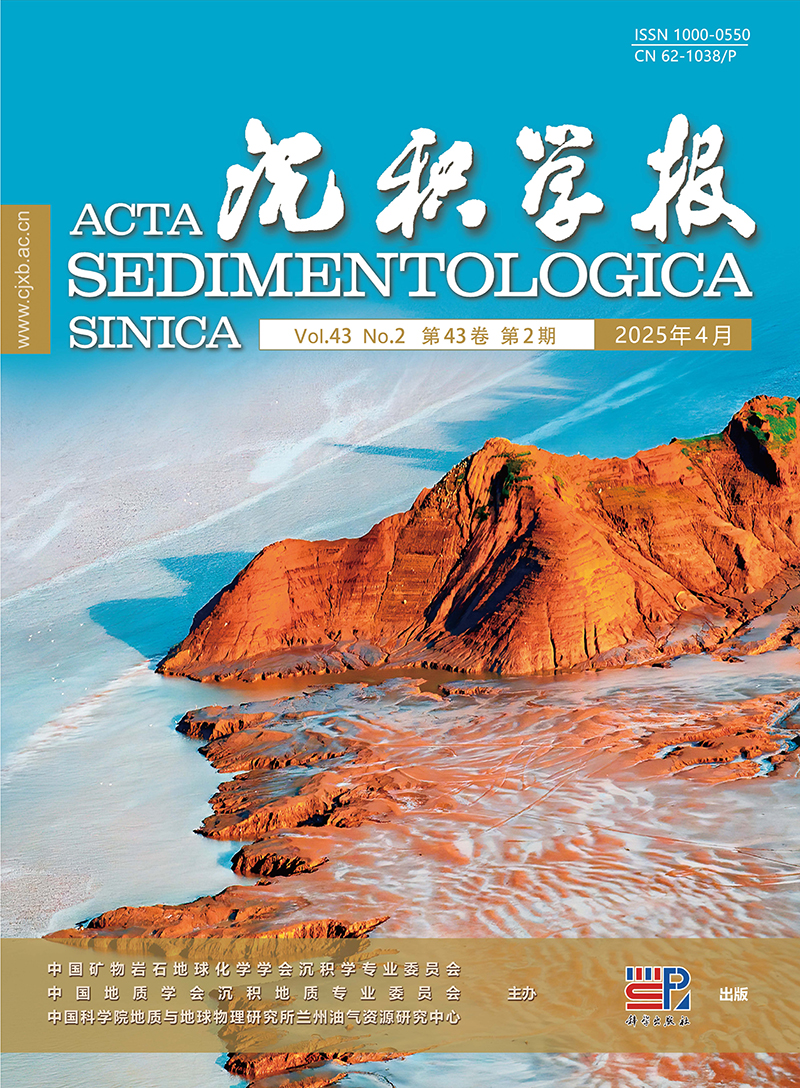


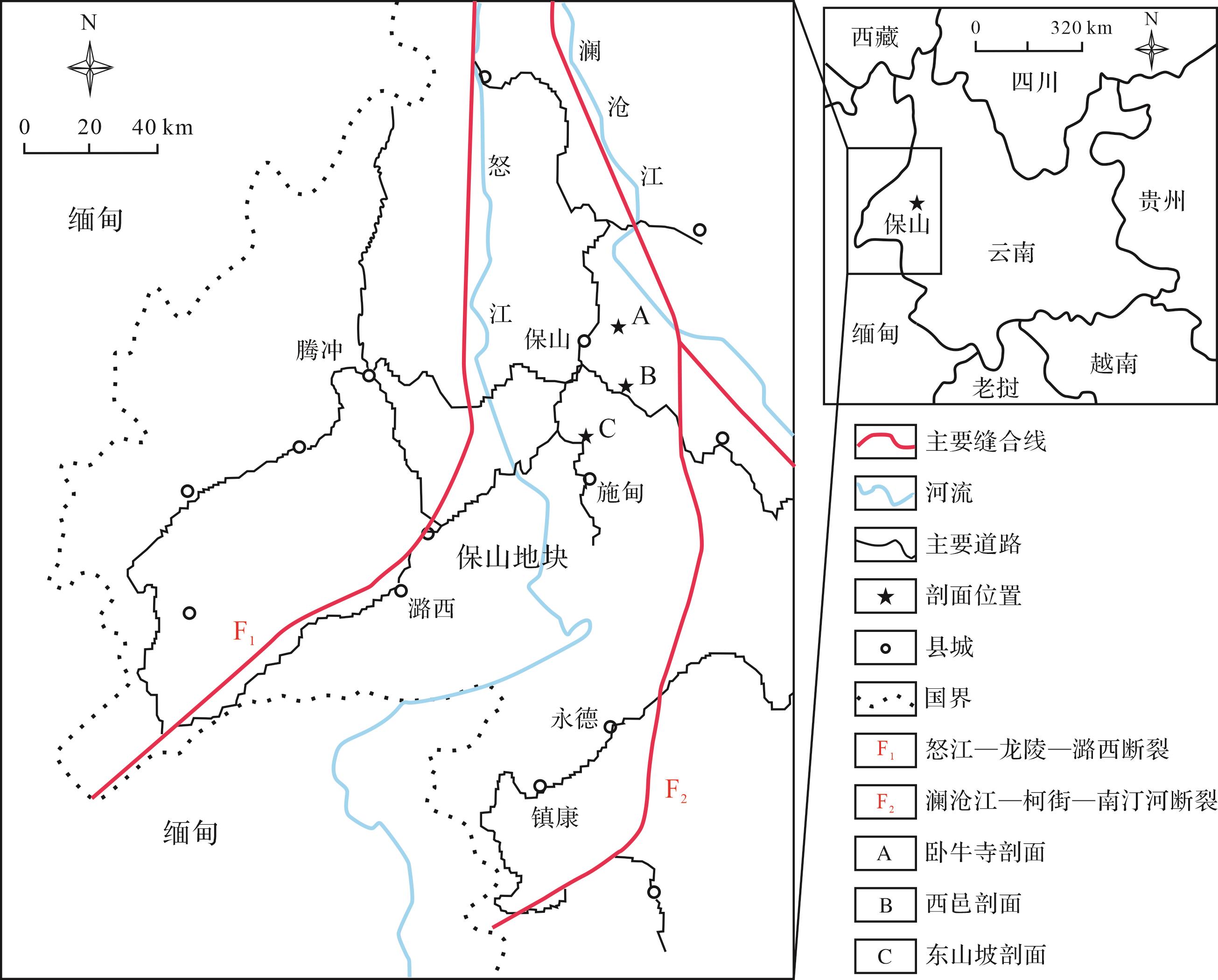






 DownLoad:
DownLoad:
